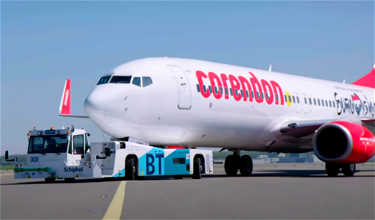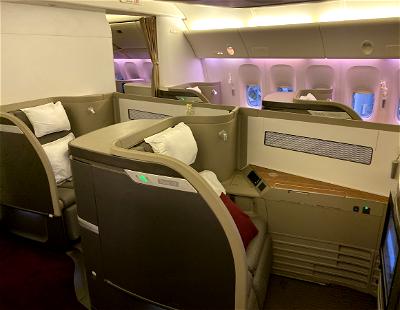Before COVID-19 changed the world, one of the biggest topics in the airline industry was the environment, and ways the industry can reduce emissions, including carbon offset schemes.
While it’s no longer the focal point for the industry, Amsterdam Schiphol Airport is moving forward with testing new technology that has the potential to reduce emissions.
In this post:
Areas where aviation can become more efficient
There are the obvious ways that airlines can become more efficient, like flying more fuel efficient planes, cramming more seats onto planes (in terms of emissions per passenger, assuming they can keep flights full), offsetting flights, and more.
However, there are some other opportunities for emissions to be reduced that don’t involve carbon offsets or more efficient planes:
- There’s talk of making air traffic control more efficient, meaning planes have to make fewer turns, do less holding, etc.
- There’s talk about the wasteful emissions while planes are on the ground; we’ve all been in situations where we’re waiting nearly an hour for takeoff with the engines running, so could we see a system whereby planes only taxi to the runway when they’re ready to go?
The issue with all of these suggestions is that there’s some tradeoff between emissions and efficiency. With airports and airspace already so congested (pre-coronavirus), it’s tough to implement some of these measures without reducing planes in the sky.
Amsterdam tests new “taxibot”
Here’s a fascinating innovation that I wouldn’t be surprised to eventually see on a widespread basis. This spring Amsterdam Schiphol Airport is testing a new “taxibot,” as it’s called.
Generally you have tugs that push planes back from gates. Once the plane is pushed back the tug disconnects, and then the plane taxies to the runway using its engines.
With this new taxibot concept:
- A tractor would transport planes to and from the runway, so that they can keep their engines off for as long as possible, instead using the power of the tractor
- This would reduce overall fuel burn on the ground by 50-85%, resulting in reduced emissions
- The taxibot can turn on its axis with four wheel steering and drive sideways, so it can maneuver easily
- The taxibot can maintain normal taxiing speeds of up to 50km/hr
For now this is in the testing phase in order to determine safety and operational feasibility, though they’re hoping to eventually roll this out on a widespread basis.
Here’s a video of the new taxibot:
Bottom line
There are so many opportunities for planes to reduce emissions on the ground, so it’s great to see a concept like this being seriously tested. The big question is whether this is operationally feasible, and can be done without making the flow of traffic significantly less efficient.
I’ll be curious to see what they determine based on the testing phase…





Heathrow Terminal 5 has had robotic tugs for years now. They don't taxi the plane to the runway but they're far more efficient than regular tugs especially because there is one for each stand and they recharge at the stand as well.
This is a total pipedream, and not to mention it was tried and proposed 15 years ago with no luck. http://news.bbc.co.uk/2/hi/business/6203636.stm
The potential savings of a couple hundred $ of kerosene per flight have not been shown to be worth the risk of having an aircraft encounter problems during the taxi, the complication of how the robots operate, and the cost of developing the robots (plus production costs).
Nice idea, but will not fly practically...
So after the tug drops off the aircraft, than what? Are they going to than drive back to the ramp area empty dodging all the other aircraft? Like another poster said. Looks good on paper.
@Polarbear
I thought we see planes pulled from the nose gear to parking spots or hangars all the time.
Well, is there a reason why you can't start em up while on the tug? N1 below 40 percent you're not generating much thrust. At AMS you could run off the APU until Victor and still have plenty of time to crank em before the Polderbaan. Save a good 20 minutes of taxiing.
1. Aircraft are towed forwards all the time around airfield.
2. Lots of reasons why this isn’t feasible. Firstly, after engine start is when you commonly find tech issues pop up because of the switch in generators and host of systems that self-test.
Secondly, systems like anti-icing need the engines running, so you’d risk accumulating significant icing prior to takeoff on the wing/fan blades.
And many other scenarios where this just isn’t practical. Classic case...
1. Aircraft are towed forwards all the time around airfield.
2. Lots of reasons why this isn’t feasible. Firstly, after engine start is when you commonly find tech issues pop up because of the switch in generators and host of systems that self-test.
Secondly, systems like anti-icing need the engines running, so you’d risk accumulating significant icing prior to takeoff on the wing/fan blades.
And many other scenarios where this just isn’t practical. Classic case of not consulting with the people who will actually use it.
Sounds good on paper though.
@Max Ah that makes sense. I was wondering why it is called a Taxibot when it is manually operated.
@Miles & Cedric - I boarded a 737 that was not pushing AC out and the Pilot stated through the loudspeakers that it was because the plane's engines were not on and the ground crew had not fastened the ground provided AC tube to the plane correctly. Makes me think that either not all planes have the APU you stated, or that most planes need their engines running to provide AC like a car.
On...
@Miles & Cedric - I boarded a 737 that was not pushing AC out and the Pilot stated through the loudspeakers that it was because the plane's engines were not on and the ground crew had not fastened the ground provided AC tube to the plane correctly. Makes me think that either not all planes have the APU you stated, or that most planes need their engines running to provide AC like a car.
On another note - always wondered why airports don't have tracks like automatic car washes. Plane lands, drives into tracks, and then is carted around the airport.
@Polarbear yes, I've read that too. It turned out being unviable, economically, as it put a lot of stress on the nose gear/air frame and therefore would need replacing earlier.
Also, wouldn't the aircraft have to be running the APU to power lights A/C etc, which is less efficient?
They'd be better off doing what Flybe did whereby they taxied their dash 8's with only one engine.
BA has actual remotely-controled tugs at LHR -- controlled by someone walking alongside.
see here https://www.mototok.com/solutions/pushback-tug
@Sam
There is another, fully-autonomous version of this vehicle. Guess Schiphol is going with the older version bacause the autonomous one is not fully certified yet.
Read somewhere that virgin tried it in the past and the problem was that planes are not designed for being pulled (vs pushed back) using nose gear.
@Cedric, I think that a plane normally uses its small Auxiliary Power Unit when it is on the ground and needs only enough power to cool the plane and make electricity.
I think that Schiphol management would get more favorable publicity if the new tug were electric powered.
The real question to me is how much emission this will really save not in percentage points but rather I would compare to planes flying for example if you will till me that with this fancy taxi bot we will reduce as much emissions as a NYC-PHL im gonna say don’t bother, but if this will make an actual significant impact and potentially improve airport efficiency then I’m all for it
This is nothing new. This is just a standard super tug with a different name. Most airlines have several of these at their hub airports. However these tugs are VERY expensive, some where @ 1 million $ per. So not really practical from a cost basis to have enough of these to work.
@Max it looks like the taxibot actually requires more ground staff to operate. There is a person in the cab in the video. Instead of being able to unhook after pushback and head back to the gate to take care of another flight, the person in the cab would be sitting there until the flight is about to take off, and then have to make a much longer drive back to the gate area.
Made by Israel’s IAI (Israeli Aerospace Industries).
@Ray, lines ups won't be an issue for a while, but you could imagine a scenario where there are a set number of taxibots, worst case the planes can just use their engines if there aren't enought bots.
I've been thinking of such a concept for years but one of the issues I see is that the aircraft usually run the engines for AC as well. In "hot" countries, this is even more of an issue.
Jet engines are not very efficient on the ground so this makes sense for sure...
Is there a minimum time for the engines to "warm up" before take off could be attempted?
The true reason for this is making ground staff redundant so they can't go on strike.
Good in theory. Will this require additional pilots training to get used to it? What if they need to make their way back from the runway to a taxiway and there’s a whole line up of aeroplanes already in the taxiway (as is often the case at airports like Heathrow)?
Makes sense in AMS given the distance to the Polderbaan from the main airport complex.